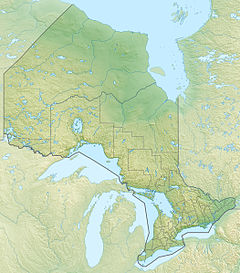English River (Ontario)
| English River | |
|---|---|
 | |
| Location | |
| Country | Canada |
| Province | Ontario |
| Region | Northwestern Ontario |
| Districts | |
| Physical characteristics | |
| Source | Unnamed lake |
| • coordinates | 49°12′54″N 90°43′37″W / 49.21500°N 90.72694°W |
| • elevation | 461 m (1,514 ft)[1] |
| Mouth | Tetu Lake |
• coordinates | 50°12′05″N 95°00′13″W / 50.20139°N 95.00361°W |
• elevation | 300 m (984 ft)[1] |
| Length | 615 km (382 mi)[2] |
| Basin size | 52,300 km2 (20,200 sq mi)[2] |
| Basin features | |
| Progression | Winnipeg River→ Lake Winnipeg→ Nelson River→ Hudson Bay |
| River system | Hudson Bay drainage basin |
The English River is a river in Kenora District and Thunder Bay District in Northwestern Ontario, Canada.[3] It flows through Lac Seul to join the Winnipeg River at Tetu Lake as a right tributary.[4] The river is in the Hudson Bay drainage basin, is 615 kilometres (382 mi) long and has a drainage basin of 52,300 square kilometres (20,200 sq mi).[2] Although there are several hydroelectric plants on this river, the English River upstream of Minnitaki Lake is notable as one of the few large river systems in northwestern Ontario with a natural flow and without any upstream source of pollution.[5] It is the fourth longest river entirely in Ontario.[citation needed]
There is also a settlement on the river called English River,[6] located where Highway 17 crosses the river at its confluence with the Scotch River, along with a nearby railway point of the same name, constructed as part of the Canadian Pacific Railway transcontinental main line.[7]
2 non-contiguous segments of the river are protected in 2 separate provincial parks: the East English River Provincial Park and West English River Provincial Park.
Geography[edit]
The English River forms in Thunder Bay District, just east of English River settlement on the boundary with Kenora District. Flowing north straddling the district boundary until Mattawa Lake, it continues northwest through Minnitaki Lake and passes Sioux Lookout, the largest town along its course. Through Lac Seul, it flows to its mouth at Tetu Lake on the Winnipeg River, which flows via the Nelson River to Hudson Bay.[4] It flows through numerous lakes during its course.
The Frog Rapids are located at Frog Rapids Narrows (50°04′12″N 91°56′52″W / 50.07000°N 91.94778°W), a short narrows on the English River near Sioux Lookout between Abram Lake and Pelican Lake. The narrows, where Highway 72 across the English River, is formed by two peninsulas between the lakes.[8][9]
Tributaries[edit]
Settlements[edit]
Settlements along its course are (in upstream order):
Fauna[edit]
The English River is considered as one of the best fisheries in Ontario. Notable trophy fish species include walleye, northern pike, smallmouth bass, and muskellunge.[10] At least 21 fish species have been identified, including sauger, yellow perch, rock bass, cisco, lake whitefish, and mooneye.[5][11]
Hydroelectricity[edit]
There are 4 hydro-electric generating stations on the English River, owned and operated by Ontario Power Generation.[12]
| Installation | Capacity | Head | Turbine units | Year built | Notes |
|---|---|---|---|---|---|
| Ear Falls Generating Station | 17 MW | 4 | 1930 | At outlet of Lac Seul, side-by-side with Lac Seul GS | |
| Lac Seul Generating Station (also known in Ojibway as "Obishikokaang Waasiganikewigamig", meaning White Pine Narrows Generating Station) | 12.5 MW | 9.78 m (32.1 ft) | 1 | 2009 | Side-by-side with Ear Falls GS, built in partnership with the Lac Seul First Nation.[13] |
| Manitou Generating Station | 73 MW | 5 | 1956 | 20 km (12 mi) downstream of Ear Falls | |
| Caribou Falls Generating Station | 92 MW | 3 | 1958 |
See also[edit]
References[edit]
- ^ a b White, James (1915). Altitudes in the Dominion of Canada (2nd ed.). Ottawa: Commission of Conservation. pp. 8, 440.
- ^ a b c "Nelson River - Rivers - Rivers Flowing Into Hudson Bay, James Bay or Ungava Bay". Atlas of Canada. Natural Resources Canada. 2010-10-25. Archived from the original on 2012-06-16. Retrieved 2012-06-23.
- ^ "English River". Geographical Names Data Base. Natural Resources Canada. Retrieved 2012-06-23.
- ^ a b "English River". Atlas of Canada. Natural Resources Canada. 2010-02-04. Retrieved 2012-06-23. Shows the course of the river on a topographic map.
- ^ a b "East English River Provincial Park Management Statement". Ontario.ca. Ministry of Natural Resources Ontario. February 2004. Retrieved 16 September 2022.
- ^ "English River (Dispersed Rural Community)". Geographical Names Data Base. Natural Resources Canada. Retrieved 2022-09-23.
- ^ "Railways – Ontario and Quebec" (Map). 1st Edition, 1906, Atlas of Canada. Natural Resources Canada. 1904. Archived from the original on 2012-07-11. Retrieved 2012-06-22.
- ^ "Frog Rapids". Geographical Names Data Base. Natural Resources Canada. Retrieved 2023-05-23.
- ^ "Frog Rapids Narrows". Geographical Names Data Base. Natural Resources Canada. Retrieved 2023-05-23.
- ^ "The Mighty English River System". www.northernontario.travel/. Destination Northern Ontario. 31 March 2021. Retrieved 23 September 2022.
- ^ "West English River Provincial Park Management Statement". Ontario.ca. Ministry of Natural Resources Ontario. February 2004. Retrieved 23 September 2022.
- ^ "Our hydroelectric stations in Ontario". www.opg.com. Ontario Power Generation. Retrieved 23 September 2022.
- ^ "Lac Seul Hydroelectric Power Plant, Ear Falls, Ontario". www.renewable-technology.com. Verdict Media Limited. Retrieved 23 September 2022.
Sources[edit]
- Map 13 (PDF) (Map). 1 : 1,600,000. Official road map of Ontario. Ministry of Transportation of Ontario. 2012-01-01. Retrieved 2012-06-23.
- Map 16 (PDF) (Map). 1 : 1,600,000. Official road map of Ontario. Ministry of Transportation of Ontario. 2012-01-01. Retrieved 2012-06-23.
- Restructured municipalities - Ontario map #1 (Map). Restructuring Maps of Ontario. Ontario Ministry of Municipal Affairs and Housing. 2006. Archived from the original on 2012-05-05. Retrieved 2012-06-23.


 French
French Deutsch
Deutsch